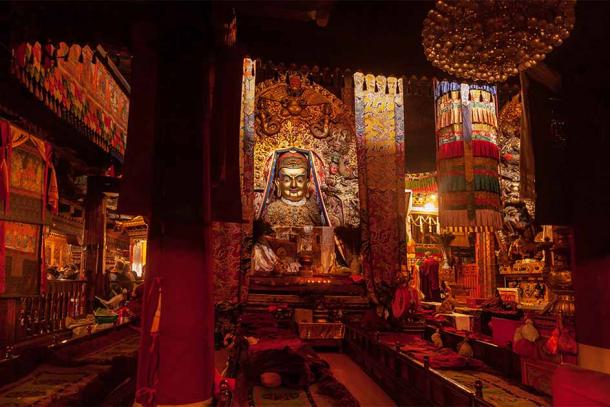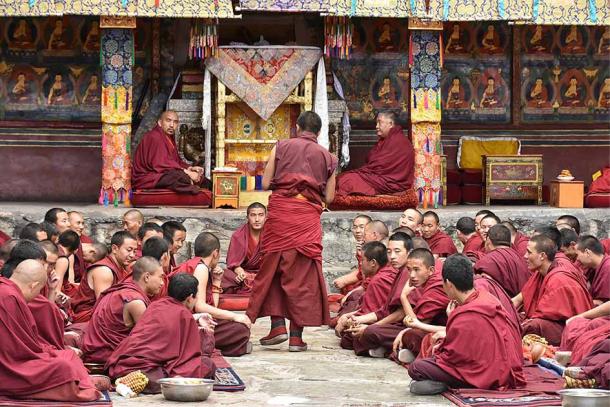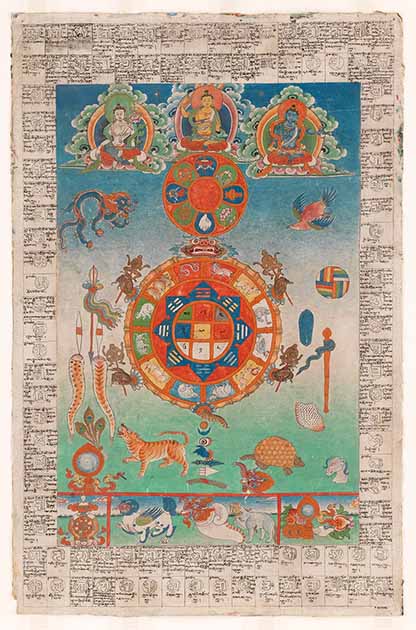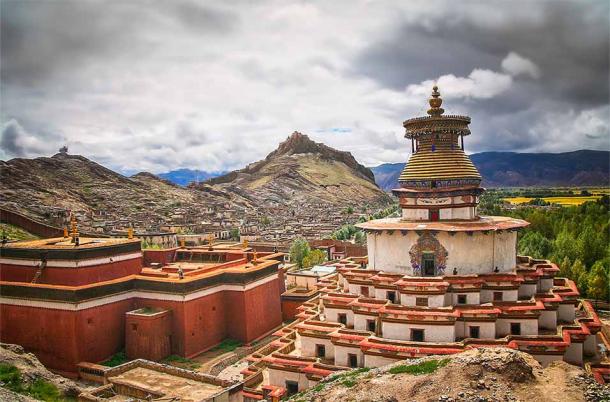
10 Awe-Inspiring Facts about Ancient Tibet
Tibet, a region nestled in the heart of the Himalayas, is a place of incredible beauty, spirituality and cultural heritage. Known for its soaring mountain peaks, vibrant prayer flags and rich tapestry of Buddhist traditions, Tibet is a place like no other. Its unique blend of ancient and modern culture, coupled with its awe-inspiring natural beauty, has captured the hearts and imaginations of travelers for centuries. From the bustling markets of Lhasa to the tranquil monasteries of the high Himalayas, Tibet is a place that inspires wonder and reverence in all who visit.
1. Tibet Has Been Inhabited for Over 21,000 Years
Tibet’s ancient history is richer than one might think. There is archaeological evidence that humans have lived on the Tibetan plateau for over 21,000 years and it’s believed the earliest inhabitants were most likely nomadic hunter-gatherers who adapted to the harsh altitude environment of the plateau.
Then, around 3000 years ago the first Tibetan civilization emerged, the Zhang Zhung culture. Zhang Zhung was located in what is now western Tibet. They were known for their relatively advanced metallurgy, agriculture and textiles as well as their fascinating belief system, the Bon religion.
- The History of the Tibetan Empire and Its Dazzling Rise to Prominence
- Tibetan Hand and Footprints May Be Oldest Prehistoric Art
The Zhang Zhung are mentioned frequently in ancient texts as Tibet’s original rulers, but it has only been in the last two decades that archaeologists have been allowed to study the areas once ruled by these amazing people. Eventually, the Zhang Zhung were absorbed into the Tibetan Empire, which emerged during the 7th century AD.
2. The Tibetan Empire Was One of the Most Powerful in Asia
The Tibetan Empire was one of the most powerful and influential empires ever to be seen in Asia and its rule extended over parts of China, Nepal, India and Central Asia. The empire was founded by Songsten Gampo who is still regarded to this day as one of Tibet's greatest-ever rulers.
During his reign, he unified various warring tribes and expanded Tibetan territory through both conquest and diplomacy. It was also he who introduced Buddhism to Tibet, which became a major element of Tibetan culture and identity for the rest of its existence.
One of the most fascinating aspects of the Tibetan Empire was its unique blend of indigenous Tibetan culture, Buddhism and influences brought in from the lands it had conquered. This empire fostered the development of a distinct Tibetan identity and this period saw the growth of Tibetan literature, art and architecture as well as the evolution of Tibetan Buddhism.
This is not to say everything was idyllic within the empire. It faced periodic uprisings and rebellions and was repeatedly invaded by neighboring states. It also faced near-constant internal conflicts among its ruling class over who should rule.

Interior of famous Buddhist Jokhang Temple in Lhasa, Tibet, created by King Songsten Gampo who founded the Tibetan Empire. (tynrud / Adobe Stock)
3. Tibet Had a Religion Before Buddhism
Today Tibet is most commonly associated with Buddhism and rightly so, the country is the site of major pilgrimages and is chock full of Buddhist shrines and monuments. However, long before Buddhism was brought to Tibet there was another fascinating religion practiced there, the Bon religion.
Not much is known about the Bon religion’s origins but it's believed to date back to around 3000 BC and was originally associated with the indigenous people of Tibet. Today the original form of Bon is sometimes referred to as Black Bon and it included elements of animism (the belief that everything is connected and everything has a soul), divination and shamanism.
When Buddhism came to Tibet in the 7th century AD the Bon religion went under massive changes. For a time, the two religions existed peacefully side by side but over time Bon was gradually assimilated into Tibetan Buddhism.
This isn’t to say Bon doesn’t exist today. There are still those within Tibet who practice Bon and maintain its unique practices and beliefs outside of Buddhism. These practices include the use of prayer flags, offering bowls, ritual objects and the performance of ancient shaman rituals and ceremonies.
The Bon religion left an indelible mark on the culture of Tibet and its identity. Its symbols and practices can be found within Tibetan art, music, and literature and it cannot be denied that its teachings left a mark on Tibetan philosophy and spirituality.
4. Genghis Khan Invaded Tibet
Tibet has been attacked and invaded by its neighbors countless times throughout history. In the 13th century the Mongols, led by the infamous Genghis Khan, were busy invading and conquering great swathes of Asia. This included chunks of China, Central Asia and the Middle East. In 1240, the Mongols set their sights on Tibet, quickly capturing its capital, Lhasa.
Surprisingly, the Mongol invasion wasn’t a terrible thing. Prior to it, Tibet had been divided into several small kingdoms with no real centralized authority. The Mongols brought a new level of political organization to the area and established a system of government that was based on their model.
It was also a remarkably peaceful process. At the time of the invasion, Tibet’s spiritual leader was Sakya Pandita, a high lama of the Sakya school of Tibetan Buddhism. He was a wise and respected leader who was able to negotiate a peace agreement with the Mongols that allowed Tibet to keep a surprising degree of autonomy.
This agreement was known as the Mongol-Tibetan Treaty of 1244. It recognized the authority of the Sakya lama and the Tibetan government and allowed them to administer Tibet under the Mongol’s watchful gaze. It also made Tibet exempt from taxation and military conscription. Genghis Khan was remarkably forward-thinking when it came to religious freedom and the Tibetans were allowed to continue practicing Buddhism freely.
During Mongol rule, Tibetan culture and art flourished. With the stability and support the Mongols offered many important Buddhist monasteries, such as the Tashilhunpo Monastery in Shigatse, were built.
This isn’t to say there weren’t some challenges. The Mongols could be brutally cruel when the need arose, and despite what the treaty said, they had a habit of meddling in Tibetan affairs. This led to tensions between different factions within Tibet, and there were periodic uprisings and rebellions against the foreign invaders' rules.

Buddhist monks at Tashilhunpo Monastery in Shigatse. (Prof. Mortel / CC BY 2.0)
5. The Fifth Dalai Lama Establish a Long-lasting Theocratic Government
In 1642 the fifth Dalai Lama, Ngawang Lobsang Gyatso, came to power following a major period of political instability and conflict in Tibet. Gyatso was the head of the Gelub school of Buddhism and after managing to unify the region under his leadership, he established a government based on Buddhist principles and which was guided by his school.
His new government was a theocratic one, meaning there was no separation between government and religion. It was organized by a hierarchy of religious and secular officials with the Dalai Lama at the top as both Tibet’s spiritual leader and political head of state. The government was responsible for everything from the administration of justice, to the collection of taxes and the provision of public services.
The benefits of this new government were that Tibetan society became more unified, sharing a sense of identity-based on Buddhism and loyalty to the Dalai Lama. This led to the development of Tibetan culture and the creation of important new works of art, literature, and music.
However, there were challenges. The government was often criticized for being corrupt and inefficient. This often led to uprisings and rebellions against Tibet's theocratic rulers. The government's reliance on religious authority also left it vulnerable to external influences, especially the influence of the Chinese government.
This form of government lasted from 1642 until 1950 when the Chinese government took control of the region. Tibet’s theocratic government was dissolved, and the Dalai Lama fled to India, setting up a government in exile. Since then there has been an ongoing debate about the role of religion in Tibetan society.
6. The Ancient Silk Road Passed Through Tibet
For those unfamiliar with it, the Silk Road was a network of important trade routes that connected China with the Mediterranean world. It was instrumental in promoting cultural and economic exchange between the East and West and being located along it came with major benefits.
The Silk Road passed through Tibet and helped to establish the area as a key location for trade and cultural interaction. Merchants traveled along the Silk Road with valuable goods like silk, tea and spices. While doing so they carried with them ideas, religions, and technology. Along the way, they established trading posts cities, and settlements that helped shape Tibet’s history and culture.

Tibetan bloodletting chart. (Wellcome Collection / CC BY 4.0)
7. Tibet Has its Own Ancient Medical System Dating Back Over 2,000 Years
It’s perhaps not all that surprising that a country as associated with spiritualism as Tibet has its ancient medical system, Sowo Rigpa. This is a holistic system of medicine based on the principle of balancing the body’s energies.
The system's roots can be traced back to the ancient medical practices of India and China, but its practitioners have developed their unique theories and quirks over time. Tibetan medicine draws on a wide range of sources such as the teachings of the Buddha, Tibet’s ancient Bon religion, and the medical knowledge of Tibet’s indigenous peoples.
- The Beauty of Death, Dying and Rebirth in Tibetan Buddhist Rituals
- Denisovan DNA in Tibetan Cave Changes History of Early Humans in Asia
Tibetan medicine teaches that the human body is a microcosm of the universe and that all aspects of the universe are interconnected (a key element of the Bon religion). A practitioner of Tibetan medicine seeks to identify any imbalances in the body and mind and seeks to restore harmony by treating the cause of these imbalances.
The system includes a wide range of treatments including herbal remedies, diet and lifestyle recommendations alongside acupuncture and meditation. Diagnostic processes are complex and include examining the patient’s pulse, urine, and other bodily fluids.
While our scientifically-minded readers might be ready to write this all off, the World Health Organization recognizes Tibetan medicine as a valid form of complementary and alternative medicine. In recent years there has been growing interest in the system among Western medical professionals.
8. The Gyantse Kumbum Displays 100,000 Images of Buddhas
One of Tibet’s most impressive monuments (which is saying something) is the Gyantse Kumbum. Located in the town of Gyantse, it was built in the 15th century and is a three-story circular building that rises to a height of 35 meters (115 feet).
The building is magnificent and decorated with 100,000 images of Buddhas, bodhisattvas and other religious figures. Its interior contains 77 chapels, each with its own collection of artwork, statues and other religious artifacts.

The Gyantse Kumbum is one of ancient Tibet’s most impressive monuments. (Pav-Pro Photography / Adobe Stock)
9. The Tibetan Mastiff is Fiercely Loyal
Here’s one for dog lovers. The Tibetan Mastiff, a powerful and protective dog breed has been used for centuries to guard homes, monasteries and livestock. The dog is one of the largest breeds in the world and is known for its loyalty and courage. Males often weigh up to around 150 pounds (68kg).
The breed has a thick coat that helps it survive Tibet’s harsh, freezing climate. Despite its large size and protective nature, the dog can also be incredibly gentle and affectionate with those it knows. This all makes it a popular companion for those who have the space and dedication to care for such a majestic breed.
10. The Tibetan Flag is Banned in China
Modern Tibet is marred by politics and the mere mention of its name can be controversial in some circles. The Tibetan flag is a symbol of Tibetan national identity and sovereignty and features a snow lion, a traditional Tibetan symbol of strength and fearlessness, and two crossed Vajirias, a Buddhist ritual object that represents the indestructibility of diamonds.
Unsurprisingly, these things have made it unpopular in China. Possession of the flag can land you with a heavy fine or even jail time. The Chinese government sees the flag as a symbol of separation and a threat to national unity. This hasn’t stopped many Tibetans from flying it, doing so at great risk to their personal safety and freedom. The flag remains an important symbol of Tibetan national identity and resistance.

The use of the Tibetan flag can be dangerous in China. (Anna / CC BY 2.0)
The Awe-Inspiring History of Tibet
Tibet is a truly unique and fascinating region with a rich cultural heritage, incredible natural beauty and deep spiritual significance. Whether you are a traveler seeking adventure, a spiritual seeker on a pilgrimage or simply someone who is curious about this intriguing part of the world, Tibet has something to offer everyone.
Its traditions, art, music and food are all an important part of the region's cultural identity and provide a window into the history and daily life of its people. By exploring Tibet, we can broaden our horizons, deepen our understanding of the world and gain a greater appreciation for the many diverse and beautiful cultures that make our planet so unique.
Top image: Representational image of a Buddhist monastery in Tibet. Source: matiplanas / Adobe Stock
References
Beckwith. C. 1987. The Tibetan Empire in Central Asia: A History of the Struggle for Great Power among Tibetans, Turks, Arabs, and Chinese during the Early Middle Ages. Princeton University Press.
Stein. R.A. 1972. Tibetan Civilization. Stanford University Press.
The Editors of Encyclopaedia Britannica. 16 February 2023. “History of Tibet” in Encyclopedia Britannica. Available at: https://www.britannica.com/place/Tibet/History
Walter. M. L. 2009. Buddhism and Empire the Political and Religious Culture of Early Tibet. Brill.
















Comments
A great article. I know a number of exTibetans but have never really looked up Tibet’s history.
From stardust I was born, to stardust I shall return
One of the 7 nations created by the interlopers; tibet, sumeria, egypt, india, rome, mesoamerica, atlantis.
infinitesimal waveparticles comprise what we call home the earth
manipulatable by thought ability supressed in humans since birth